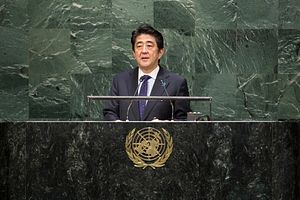Japan and its two decades of economic stagnation seem as if they’re about to have company. The International Monetary Fund and OECD both seem prepared to lower their global growth forecasts for the coming year because of what they see as a continuing slowdown in the global economy. Foreign Affairs even devoted its most recent issue to surviving a slow-growth future. David Lipton, the IMF’s first deputy managing director, recently warned of the perception within markets that policymakers have run out of ammunition or the resolve to use it and asked governments to do more to stimulate demand through “pro-growth” fiscal and monetary policies and structural reforms.
Lipton’s recommendations will sound familiar to any who follows Japan’s economy and Prime Minister Shinzo Abe’s three-year-old “Abenomics,” a three-arrowed growth strategy comprising fiscal, monetary, and structural reform. Recently, Abenomics has taken a beating as Japan’s economy hasn’t grown at the pace anticipated by policymakers, and economists and business leaders are losing confidence in the plan’s efficacy. Plus, the “virtuous cycle” created when higher corporate profits cycle into wage growth, which cycles into higher consumption and so on, hasn’t been able to get started. The Bank of Japan’s shock decision to go to negative interest rates was almost immediately offset by a sudden rush toward the yen as investors looked for safe investments amidst slowdowns in China and emerging economies—a vote of confidence in Japan’s economic fundamentals, but a blow to the Bank of Japan’s reflation goals.
Any criticism of Abenomics—and there has been plenty, especially after the most recent GDP data indicated that Japan’s economy was contracting by 1.4 percent—needs to account for the fact that in the context of the global economy, no one is really growing right now. Every G20 economy except two has failed to meet their growth projections since 2010. In fact, only Japan and the United States are growing at rates similar to their pre-crisis growth, after adjusting for changes in the working-age population.
As U.S. economist Zachary Karabell points out—using Japan as his main example—economic stagnation does not necessarily mean a concurrent stagnation in living standards. Japanese workers haven’t seen their purchasing power decrease since wages and prices have been more or less constant, and stagnation hasn’t created an acute crisis like what’s been seen in Greece or Spain, nor has it created the populist discontent seen in the United States, Europe, or elsewhere. There’s also not much to indicate that another acute financial crisis is inevitable, even with growth slowing. A slow-growth status quo may not be exciting, but is it good enough as long as living standards hold?
The problem is that demographics make the status quo unsustainable—on February 26, the Japanese government reported its first population decline since it began the census in 1920. Japan’s economy may have been able to survive stagnation, but it needs to do more than just stagnate in order to maintain its standard of living and survive the coming demographic collapse. The threat of global stagnation only adds to these headwinds.
But just as critics should remember the global context when thinking about Japan’s economy, so too should the Japanese government. While there is generally consensus among observers—especially among Japanese firms and many economists—that the Abenomics formula was the right approach to restarting growth, diminishing results from Abenomics’ implementation along with a stagnant global economy means that a strategy that was right for a global economy recovering from the Great Recession and buoyed by emerging market growth will not be the same strategy to face the headwinds of global stagnation. If Japan needs to work harder to meet its targets, its strategy should reflect that.
At the international level, Japan is fortunately well-positioned to take a lead role in a global growth strategy not only given its chairmanship of the upcoming G7 conference, but also because it has wrestled with the same problems—slow growth, declining population, and stagnant productivity—that the international community is beginning to struggle with. Abe has already announced a plan to launch talks with international economic experts in the lead up to May’s G7 conference to discuss ways to stabilize the world economy.
Any outcome from the experts’ meeting or the G7 conference would not need to be a modern iteration of the 1985 Plaza Accord (nor is it likely) in which the G5 agreed to align their currency levels. But as central bankers look for new ammunition, coordination and transparency among G7 partners and the rest of the international financial community will be essential. It could at least help calm markets and provide firms a greater sense that the future is being planned for.
And even if internationalizing the issue and creating a global discussion on how to respond to stagnation do not create a framework for a response, it may still help give Japanese policymakers the political cover to take bolder and more innovative measures to encourage domestic growth. Though Abenomics needs more work, now other economies may be about to realize the difficulty of Japan’s situation. Better coordination and planning could make the job easier for everyone.
Paul Nadeau is an independent writer based in Tokyo, Japan.

































